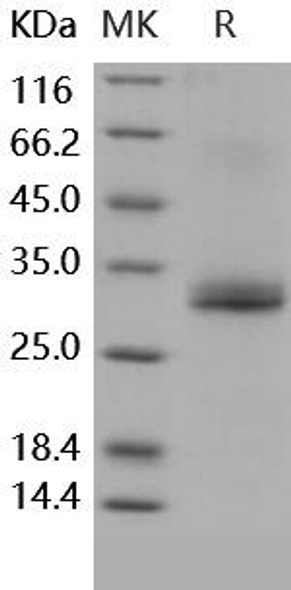| Sequence: | MERCPSLGVTLYALVVVLGLRATPAGGQHYLHIRPAPSDNLPLVDLIEHPDPIFDPKEKDLNETLLRSLLGGHYDPGFMATSPPEDRPGGGGGAAGGAEDLAELDQLLRQRPSGAMPSEIKGLEFSEGLAQGKKQRLSKKLRRKLQMWLWSQTFCPVLYAWNDLGSRFWPRYVKVGSCFSKRSCSVPEGMVCKPSKSVHLTVLRWRCQRRGGQRCGWIPIQYPIISECKCSC |
| Accession: | Q13253 |
| Storage: | Generally, lyophilized proteins are stable for up to 12 months when stored at -20 to -80°C. Reconstituted protein solution can be stored at 4-8°C for 2-7 days. Aliquots of reconstituted samples are stable at < -20°C for 3 months. |
| Shipping: | This product is provided as lyophilized powder which is shipped with ice packs. |
| Formulation: | Lyophilized from a solution containing 0.1% sarkosyl in 1X PBS, pH8.0. Normally 5 % - 8 % trehalose, mannitol and 0.01% Tween80 are added as protectants before lyophilization. Please refer to the specific buffer information in the printed manual. |
| Reconstitution: | Please refer to the printed manual for detailed information. |
| Background: | Noggin is a secreted protein involved at multiple stages of vertebrate embryonic development including neural induction and is known to exert its effects by inhibiting the bone morphogenetic protein (BMP)-signaling pathway. It binds several BMPs with very high (picomolar) affinities; with a marked preference for BMP2 and BMP4 over BMP7. By binding tightly to BMPs; Noggin prevents BMPs from binding their receptors. Noggin binds the bone morphogenetic proteins (BMP) such as BMP-4 and BMP-7; and inhibits BMP signaling by blocking the molecular interfaces of the binding epitopes for both type I and type II receptors. Interaction of BMP and its antagonist Noggin governs various developmental and cellular processes; including embryonic dorsal-ventral axis; induction of neural tissue; formation of joints in the skeletal system and neurogenesis in the adult brain. Noggin plays a key role in neural induction by inhibiting BMP4; along with other TGF-β signaling inhibitors such as chordin and follistatin. Mouse knockout experiments have demonstrated that noggin also plays a crucial role in bone development; joint formation; and neural tube fusion. |






